|
Venezuela Part 2 - Gulf of
Cariaco 11th - 29th February 2004 |
|
After our week long enforced marina stay, we set
off into the Gulf of Cariaco, in search of a secluded anchorage.
Although we spent three years living aboard in a marina before we left Wales
and enjoyed it, it's a different story when you're living in a marina
surrounded by other boats with people living aboard. We're now
accustomed to anchoring everywhere, which affords a greater degree of
privacy.
With the anchorage we chose to visit first,
we were not disappointed. Laguna Grande is a large, protected
area of water, almost entirely surrounded by hills, with only a narrow
entrance. You could easily sail past the entrance without ever
knowing it was there. The two days we were there we only
saw three other yachts - quite a change from the crowded Eastern
Caribbean! We were spoilt for choice with a dozen or more anchoring
spots and after motoring around them all in Anju, settled for the first
night in the most remote spot, about two miles into the
lagoon.
|
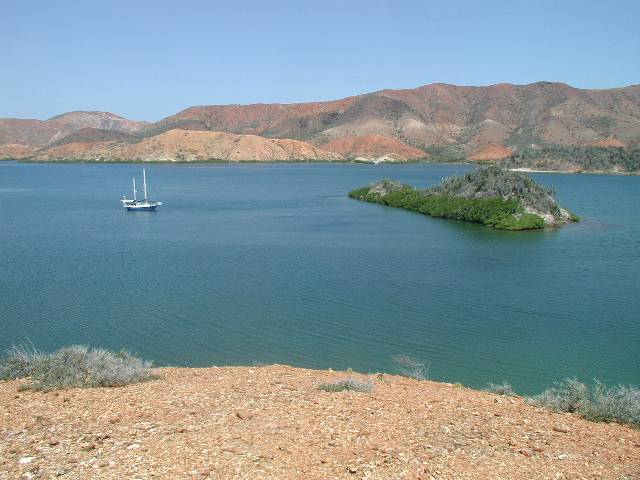
Tranquil Laguna Grande
|
|
The weather was a little overcast, which made it
perfect for exploring on foot during the afternoon. Normally there
would be no shade and scrambling up the hills of loose shale would be hot
and exhausting work. From the top of the hill we chose to climb,
the view was stunning, the entire lagoon on one side and miles and miles of
deserted arid landscape all around, not a sign of habitation in any
direction. When night fell, the anchorage was incredibly dark
with no light anywhere and the sounds of the nocturnal wildlife quite
spooky.
Next day when we'd relocated to a different
anchorage we did encounter signs of human life. Local fisherman
were busily wading out into the shallow water at the shore and harvesting
all kinds of shellfish from the soft mud, not the most appealing of
jobs! Just by the entrance to the lagoon, hidden away behind a
small island, was a fishing camp and later in the day two children from the
village came to call. They very politely asked if we could spare any
food and unlike other kids we've met, they weren't after sweets and junk
food, rather a little powdered milk and some spaghetti. They
were very curious about where we were from and well mannered. They
happily rowed away back to their camp with their food, some fishing line,
hooks too, as well as a couple of fizzy drinks and some chocolate biscuits
to sustain them for the trip.
|
|
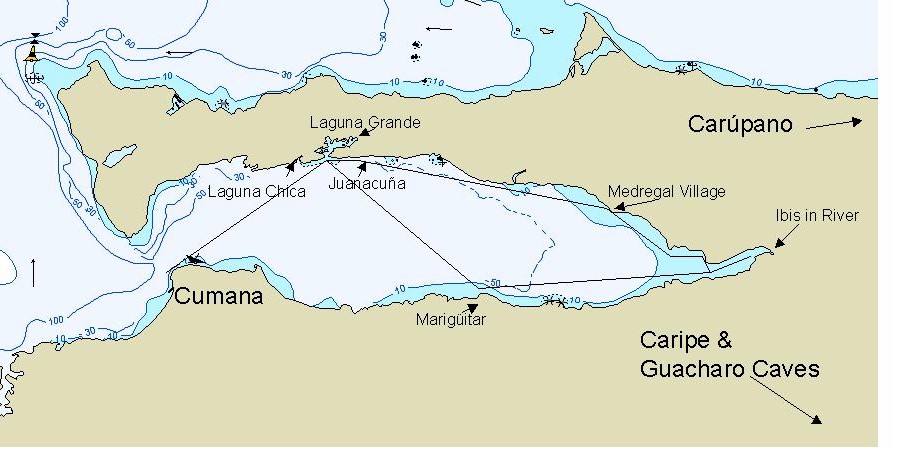
Gulf of Cariaco, Venezuela
|
|
Each afternoon the winds would howl from the
east, twenty five to thirty knots for several hours, so each time we moved
to a different anchorage, we were sure to make an early start, to avoid
motoring into the strong winds and the waves which quickly
appeared. Our next anchorage was a tiny bay called
Juanacuña. From the outside, we were dubious about whether
there was actually room for Anju to swing on her hook in the bay but decided
to give it a try. Ashore was a small resort, with thatched bar
and hotel rooms but unfortunately they were renovating and not open for
business. They gave us complimentary coffee and told us they
were happy to open up the bar on demand though. Now we were
anchored in clear water, we decided it was time to clean our prop of any
accumulated growth. However we weren't prepared for the chilly
water, which was a nippy 22 degrees centigrade. Later we did
brave the cold and take a snorkeling tour of the rocky headlands in the
bay. Although there were not may reef fish living there, we were
rewarded with the best collection we've seen yet of brightly coloured worms,
in shades of pink and purple, living on the reef. Of course back
at the boat our post-snorkel shower was icy cold too - why didn't we get
that hot water tank?
|
|
Next day we were ready to get back to
civilisation and headed to the cruiser's favourite spot in the Gulf, the
anchorage off the Medregal Village Hotel. The whole way there we
spotted only three or four tiny settlements on the north shore.
We arrived at Medregal to find about a dozen boats at anchor and quickly
found out why when we went ashore. Jean Marc, the Belgian owner
of the hotel and his beautiful Venezuelan wife, Yoleida, allow the crews of
visiting yachts to use all the hotel's facilities, including a swimming pool
(much warmer than the sea!) and HOT showers for free. The bar
was available at all times on a trust basis, you just kept your own tab
going and paid up when you left. It was like a holiday paradise
for weary travellers! We'd also arrived just in time to
enjoy that evening's barbecue, to celebrate Valentine's Day, the perfect
occasion to celebrate our wedding anniversary which fell on the following
day.
|
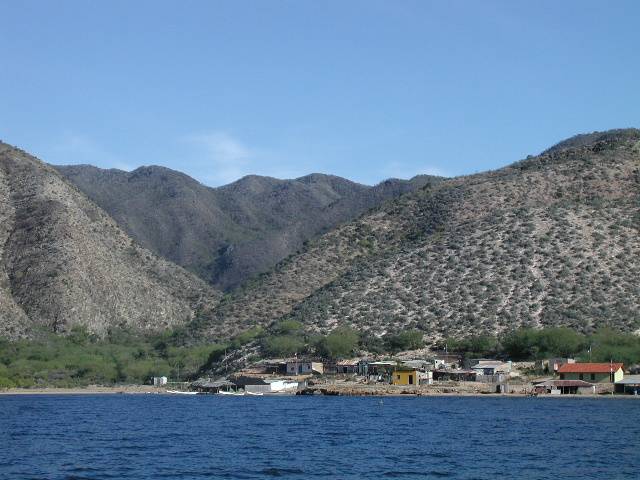
Typical settlement on the
north side of the Gulf.
|
|
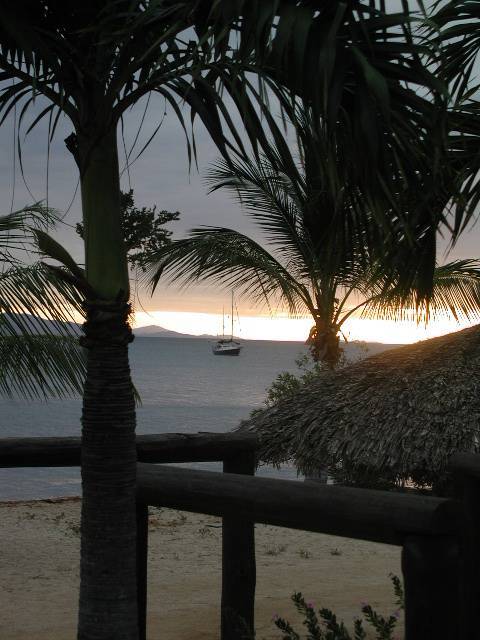
|
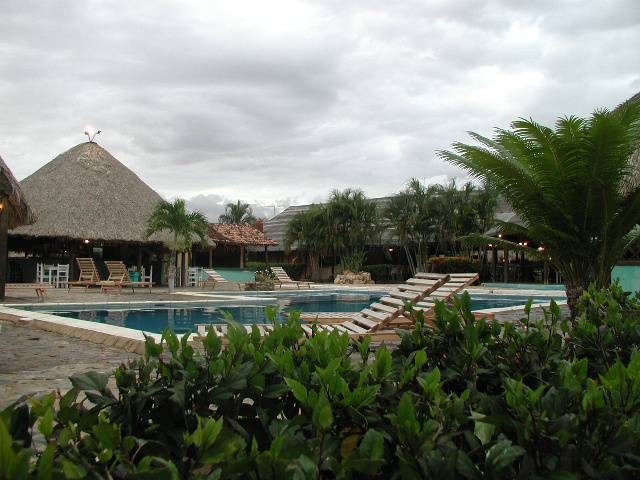
Jean Marc and Yoleida's Medregal Village
Hotel - Holiday Resort for weary cruisers.
|
|
A couple of days later we managed to drag
ourselves away from the pool and bar, to take a trip inland to the Guácharo
Caves, near the town of Caripe. We travelled in Jean
Marc's landcruiser with Harm and Lizzie from the Dutch schooner Horta.
The trip to the caves took about three house, with a stop for coffee and a
quick visit to the village of Catuaro to see the old church, destroyed in
the war with the Spanish and to pick up some empanadas (pasties) to tide us
over until lunchtime.
The Guácharo caves are named after the bird
which resides in the outer chamber of the cave network, known in English as
the oilbird. On our trip to the Asa Wright Bird Reserve in
Trinidad, we'd heard the raucous calls of the birds but weren't able to
visit their cave.
|
|
By the light of our guide's oil lamp, we were
able to see the oil birds roosting on the walls of the cave and some small
bats, which he told us were vampire bats which feed on the birds. The noise
made by the birds when disturbed was incredible, more like angry big cats
than birds. When they flew they made a clicking sound like a bat, as they
use a similar type of sonar system to fly in the dark. We also spotted
crickets, spiders and rats before heading further into the darker part of
the cave. Beyond the first chamber, where the oilbirds live, we
were allowed to take photographs but this had to be done entirely by
guesswork. In the dark you couldn't see what you were photographing at
all. Thank goodness we have a digital camera and didn't have to
pay to develop all the shots where we missed our target!
Walking was quite tricky sometimes as we only
had the faint light of the one lamp to find our footing. Luckily we didn't
come in rainy season, when you have to wade through water most of the way
inside! Our guide showed us many interesting stalactite and stalagmite
formations, most of which seemed to have phallic or religious descriptive
names. There was also one called "el tambour" or the drum, which
made a noise like a kettle drum when you tapped it with your fingers. There
were a couple of small holes we had to crawl through. The total
distance we covered was about 1.2 kilo metres. The cave goes on about
another 10 kilometres but often you have to crawl or swim and only
specialist cavers are allowed to visit those areas. It was a very
interesting visit.
By now it was lunchtime and Jean Marc drove
us to the picturesque town of Caripe, to the restaurant at "La Posada
del Gallego" which had fabulous views of the mountains and was run by a
Galician man from Pontevedra. The owner was very interested in talking about
the places we'd visited in Galicia and the complimentary tapas we were
offered as we made our selections from the menu were definitely Galician
style seafood.
|
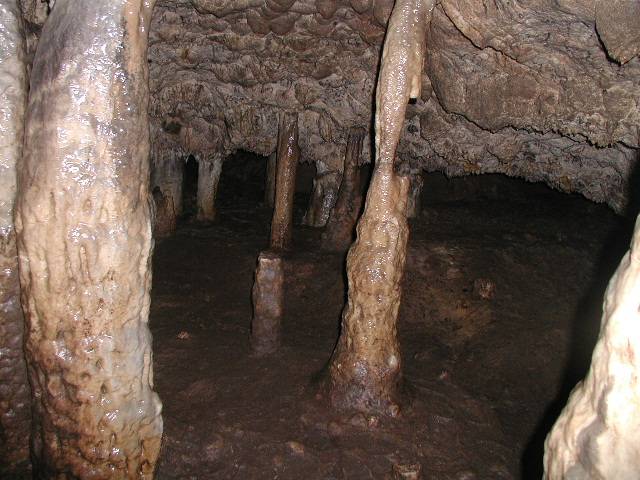
Guácharo Caves
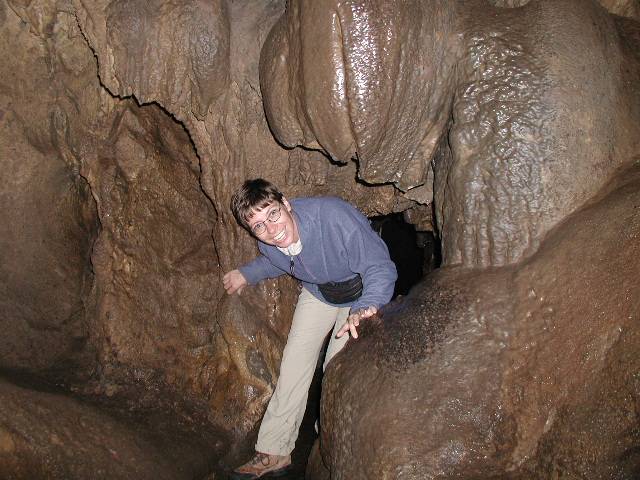
Christine clambering through one of the
smaller passages.
|
|
After our substantial lunch, Jean Marc obviously
thought we needed more nourishment and our next stop was the "Palacio
de Fresas" (Strawberry Palace) in Caripe. There we enjoyed
the best tasting strawberries we've ever eaten, with cream of
course.
Our return trip passed through the scenic,
mountainous countryside of the states of Monagas and Sucré. It was
very obvious from the state of the roads and the style of the housing that
Monagas is the second richest state in Venezuela, whilst Sucré is the
second poorest. We stopped at the town of Muelle de Cariaco,
famous for it's pottery and were able to see a talented craftswoman at work
making clay statues.
|
|
A couple of days later we took another trip with
Jean Marc and Yoleida to the town of Carúpano on the north coast of
Venezuela. They were heading there for supplies for the hotel
and we had a chance to look around the bustling city centre and enjoy
another great lunch before heading back via the scenic mountain route to
Medregal. It was a pity that it was misty, so we missed out on
the best views but the trip was an experience in itself and during the trip
our lunch was well and truly shaken down due to the state of the road
! The transmission of the truck got so hot that when we got
back, we found the chicken we'd bought and stupidly placed above it, was
almost cooked!
|
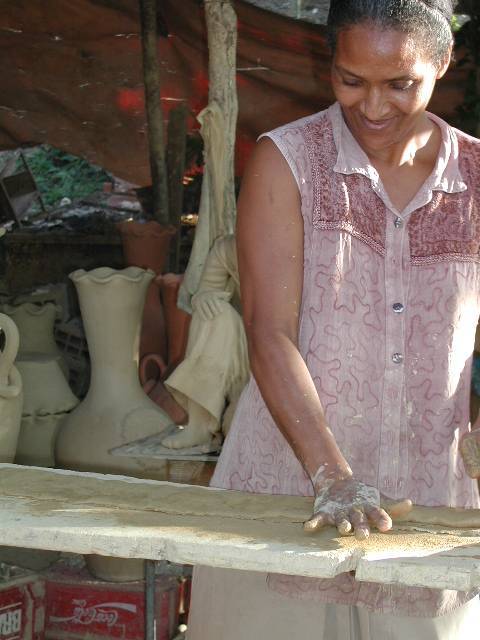
Potter in Muelle de Cariaco.
|
|
Mountain road back to
Medregal
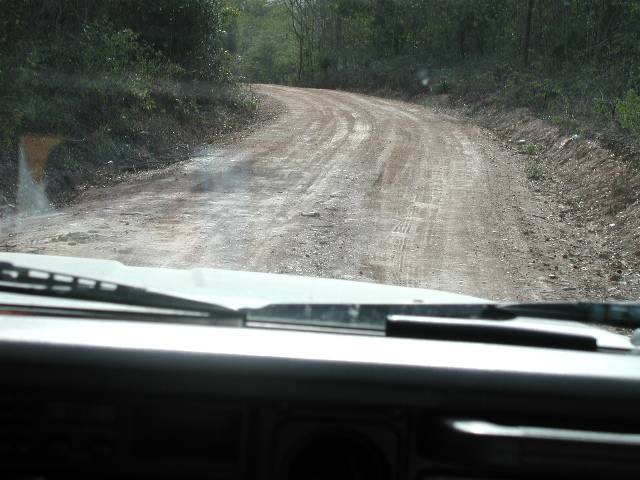
|
Before we left the anchorage at Medregal Hotel,
it was carnival time and Jean Marc laid on a special hog roast to
celebrate. Next day we also enjoyed dinner with JB and Michelle
on Philani, a South African boat and we were treated to the South African
delicacy of "Bobbity" (excuse spelling if incorrect) - a very
tasty mince concoction.
Finally we had to drag ourselves away, we
could have stayed there longer but our plan to get to Cuba this year was
always at the back of our minds, so we moved on to an anchorage at the very
head of the Gulf of Cariaco, near the village of Muelle of Cariaco.
The village used to be the hub of all transport to the town of Cariaco and
the surrounding area before the road was built but now is a small village of
fishermen and potters of course.
|
|
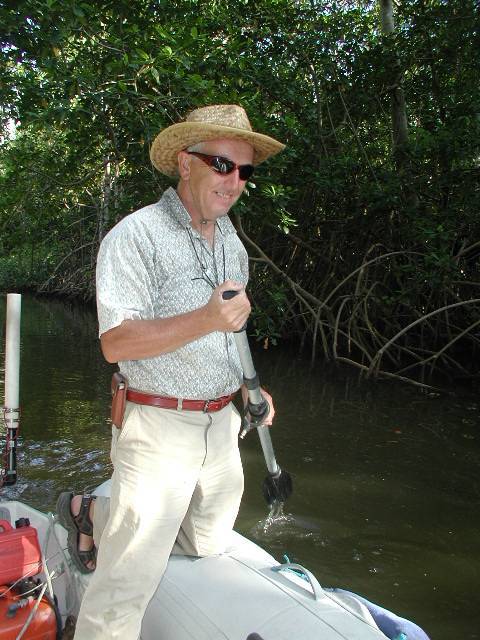
Intrepid Explorer
|
The reason for our visit to Muelle was to take a
trip up the river at the head of the Gulf in search of the Scarlet Ibis
which roost there. We wanted to anchor Anju as close as
possible to the river mouth and edged gingerly closer and closer in very
shallow water. Anju draws 2 metres and once our depth
sounder hit 0.8 metres below the keel, we decided we'd gone far enough and
dropped our hook. At around 3 pm we set off in the dinghy
to explore further up the river. It turned out that this was the
perfect time to go as we saw many of the unbelievably brightly coloured Ibis
as well as large white and grey herons and vivid kingfishers roosting in the
trees. We motored up against the river current and paddled
back downstream. We were baffled by the frequent loud popping noises
we could hear along the way. Finally we came across a couple of local
fishermen in a small boat and asked them what was making the
noise. They told us it was the sound of drying matter in the
mangroves, we were quite surprised as we'd thought it may be insects or
frogs but couldn't see any sign of either. They also warned us of some
lurking evil which would appear after sunset. Our Spanish wasn't up to
working out whether it was blood-sucking insects, blood-sucking bats or
banditos but we decided as the light was fading to head back to Anju, just
in case!
|
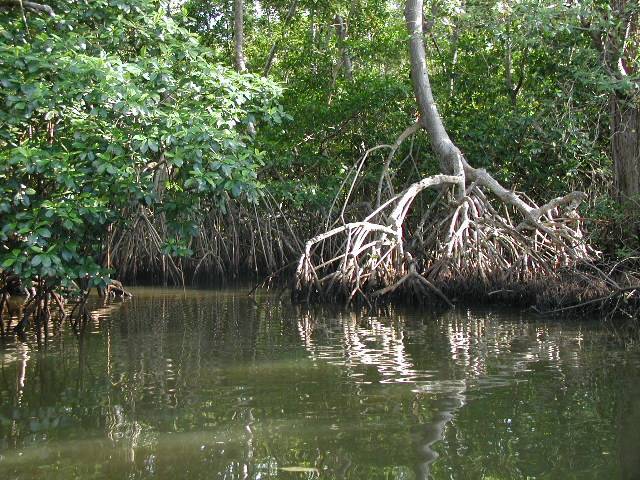
Finding our way through the
mangroves.
|
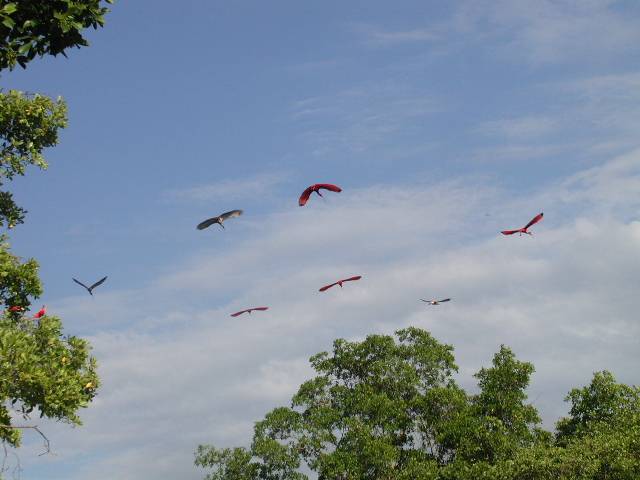
Scarlet Ibis
|
|
It was time to start moving west again and on
our way back to Laguna Grande, we decided to call in at the town of
Marigüitar on the south side of the Gulf, as we'd only visited the more
sheltered anchorages on the north. As we motored there in a dead
calm, we figured it was probably a good time to visit. The bay
shelved quite steeply, so we had to anchor fairly close in to the beach, not
normally a problem when the wind almost always blows from an easterly
direction. As usual we were cautious and didn't pick a spot too
close in, which was lucky because as soon as we'd dinghied ashore and
ordered our lunch at the very attractive Club resort on the beach, the wind
suddenly decided to blow from the west. This meant that Anju
although not in immediate danger, was uncomfortably close to the
beach. We wolfed down our lunch hurriedly paid the bill and
rushed back before the waves started to build. As soon as
we were back we hauled up our anchor and headed out of the bay. It was
a real pity as we'd have liked to stay longer. Typical when the
pilot book tells us that strange westerly winds blow only every couple of
months, that it should pick the most inconvenient moment to do
it. That's normal in sailing.
Of course, as we were heading north west to
Laguna Grande, we ended up beating to windward instead of sailing downwind
but it was nice to have a chance to actually sail without using the engine
and the dolphins who accompanied us most of the 8 mile distance took our
minds of the indigestion!
After another day of peace in Laguna Grande,
disturbed only by a fierce game of dominos with JB and Michelle of Philani,
we headed back to Cumaná. Our dolphin friends kept us company
again and even waited for us when we turned around into the wind to drop our
sails. In Marina Cumanagoto we were greeted like old
friends by a welcoming committee of five or six of the marina's employees,
all anxious to know if we were feeling better. We told them we
definitely wouldn't be eating Chinese food this time!
|











